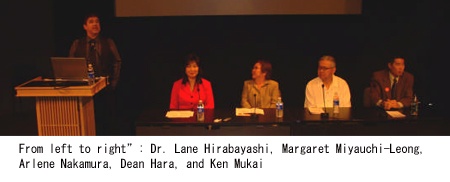A program titled “Kenjinkai: Past, Present, and Future,” which explored the current relevance of kenjinkai (Japanese prefectural associations), was held on March 28 at the Japanese American National Museum.
Our own Margaret Miyauchi-Leong, Vice-President for Southern California, was one of four panel speakers. The others were Arlene Nakamura of Yamaguchi Kenjinkai, Dean Hara of Mie Kenjinkai, and Ken Mukai of Hiroken. Dr. Lane Hirabayashi of the UCLA Asian American Studies Department was the moderator.
The two-hour program began with a video showing the history of the kenjinkai in America. After the video, the four panelists gave their presentations. Margaret was first up with an excellent PowerPoint that started with an introduction to the Kagoshima Kenjinkai. Our group was founded in 1899, making it the oldest of the kenjinkai—110 years old this year! Many photos taken during the “vital days” were included showing association dinners, summer picnics, and volleyball tournaments. In 1983, the Kagoshima Junior Club was established when it was found that the majority of kenjinkai members were over 60 years old. The members were the children of the original kenjinkai members. They planned social activities such as beach parties, dances, and ski trips to Mammoth. By 1993, the dilemma of a dying kenjinkai still had not been resolved, so the members of the Junior Club decided to change its name to the Kagoshima Heritage Club, elect a new board, and concentrate more on garnering knowledge about our roots in Kagoshima. Since then, the KHC has taken cultural outings, put on educational workshops, and done scholarship fund-raising. On its tenth anniversary in 2003, many KHC and kenjinkai members went to Japan, visiting their ancestral towns and connecting with their counterparts at the Kagoshima Chamber of Commerce.
The presentations by Arlene, Dean, and Ken followed Margaret’s, and their talks also addressed the big question: How to evolve to attract new members? Arlene mentioned that a hundred-year tradition for Yamaguchi Kenjinkai has changed recently—now all meetings are held in English, with a summation given in Japanese at the end. Dean added that the challenges for Mie Kenjinkai include lack of participation in events due to the youth being involved in so many other extracurricular activities. Ken added much laughter to this event with his humor-filled presentation, often mentioning that his was the only kenjinkai that owned its own building*. What with all the gentrification occurring in Little Tokyo these days, that piece of property must be worth a bundle! Hopefully, we can ask Ken if some of our meetings could be held on his “turf,” since we do not have the benefit of owning a building and usually have to pay a fee to hold an event!
The question and answer portion that followed was much too short—twenty minutes for a very weighty topic! The first question was asked by a young man who wondered whether we could start using social networking sites such as Facebook to put the word out. This is the way young folks today communicate, and it costs nothing! The suggestion to do more direct networking with college groups such as UCLA’s Nikkei Student Union was suggested by Lane. Some of the panelists stated that their kenjinkais’ membership was open to all—not just those whose ancestors hailed from their part of Japan. That brought up a question from an audience member about what the benefits of membership would be for a person who didn’t have roots in that part of Japan. In fact, Hiroken has a Caucasian member who joined because he lived in Hiroshima for several years and feels an affinity for the area.
The program ended with performances by three talented students who are former Nanka Kenjinkai Kyogikai scholarship recipients. Stephanie Miyauchi Chung played a piece on the koto (Japanese harp-like instrument) called “Maboroshi” (Mirage) with both skill and emotion. Next up was Ashley Arashiro, a veteran of fourteen years of martial arts training, who did a demonstration that showed how she has come to earn many gold and silver medals. A graceful Japanese dance called “Kyonoshiki” was performed by Trisha Asao, who has been studying this ancient art since she was seven years old.
It was during these three cultural performances that I became wistful at what I perceived as a lost opportunity. Wouldn’t it have been great to hear what these three young people had to say about the future of the kenjinkai? What got them interested in traditional Japanese arts, and had that interest transferred over to an interest in their roots in Japan? Yes, we needed to hear from more young people!
As I was leaving the auditorium, I heard a woman make an excellent suggestion about having a common website for the kenjinkai, with links to the different groups, also. If anyone has suggestions for keeping the kenjinkai alive, please e-mail Tim Asamen at timasamen@yahoo.com with your suggestions, so we can post them in our future newsletters.
Editor's note:
* Hiroshima Kenjinkai is not the only Southern California kenjinkai association that owns a building. The Okinawa Association of America (aka Okinawa Kenjinkai) also has its own building in Gardena, CA.
*This article was originally published on Kagoshima Heritage Club Newsletter Vol. 61 (Spring 2009).
© 2009 Kristine Haenschke




